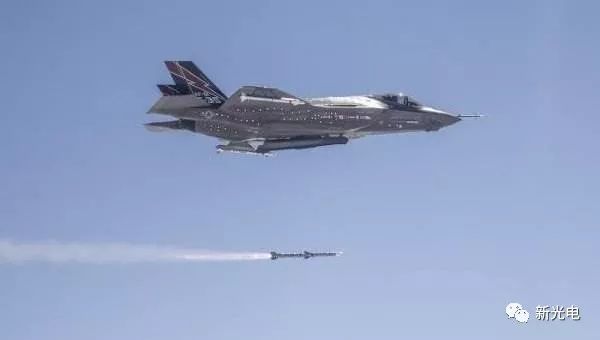After the US F-35 battle was equipped with the AIM-120 advanced medium-range air-to-air missile, most of the North Korean launch sites were within its shooting range. Thus, the US Air Force envisaged that within two seconds after the launch of the North Korean "Mars" 15 intercontinental ballistic missile on November 28th, the F-35 fighter could be used to launch an AIM-120 missile to engage the "Mars" 15 and destroy it. This is not a fantasy or a blow. It is a way for the US Department of Defense to implement dynamic interception of North Korean or Iranian ballistic missiles in the future.

In early November 2017, at an event held by the US Alliance of Missile Defense Supporters in Washington, DC, Duncan Hunter, a member of the US House of Representatives from California and a member of the Strategic Armed Forces Committee of the House Armed Forces Committee, said He supports the above-mentioned boost segment interception concept, and the F-35 fighter should shoot down ballistic missiles before they fly out of the atmosphere. He said that some parts of the Korean territory are only 75 miles (120 kilometers) wide, and the AIM-120D missile has a sufficient range to cover; for Iranian ballistic missiles, it can be aimed over Kuwait. Mr. Hunter also said that his office has been working in the Los Angeles Alamos Laboratory and Livermore Laboratory of the US Department of Energy, and proposed a road map for using the F-35 and the AIM-120 missile for missile defense.
Earlier, after North Korea tested the "Mars" 15 missile, two US senators - James Inhofe from Oklahoma and Dan Sullivan from Alaska began Seek funding for the development of booster interception methods. They are seeking to set up a “quick development and deployment†project for the “High-altitude long-term booster segment interception†system and arrange for a special fund of US$100 million. The system will be equipped with airborne laser weapons on the Nobel RQ-4 Global Hawk UAV. The two MPs wrote in a letter to the Defense Subcommittee of the US Senate Appropriations Committee on December 1st: "The system is technically feasible and relatively low cost, and can be completed within 12 to 18 months."
The US military now has sea-based and land-based ballistic missile defense capabilities, which can be intercepted from the middle to the end, but the interception and ascending sections have insufficient interception capabilities. The first 300 seconds after the ballistic missile is launched is the most critical time period to eliminate its threat, especially the first 90 seconds, because the ballistic missile is the slowest and the engine is hot. The United States has tried many methods, including installing a megawatt laser weapon on a YAL-1 aircraft modified by a Boeing 747. But most options are unrealistic and expensive. If it is effective, it is much simpler to use fighter interception. Boeing's F-15 flight altitude is high, or it will be an excellent candidate; the F-35 fighter combines sensors, sensor fusion and stealth features, making it an ideal candidate for interception.
Tom Lawhead, director of the US Air Force F-35 Fighter Program Office, said that for years, Nogg has been testing the F-35's ability to detect and track ballistic missiles. The company is the developer of the AN/AAQ-37 photoelectric/infrared distributed aperture system and the AN/APG-81 active phased array fire control radar on the F-35. In October 2014, Nogg conducted an end-to-end ballistic missile detection and tracking test using a land-based distributed aperture system and a test bed aircraft equipped with AN/APG-81 radar. Information is corrected through the data link to generate targeting data that meets the needs of the interception operations, and is accurate enough to be used by the Aegis anti-aircraft anti-missile system on the AIM-120 missile or destroyer.
Rohed said: Missile defense is not the ability of the F-35 to be required for on-going projects, and much analysis is needed. But he also said that this is feasible, and that Nogg believes that it will take only three years to complete the integration of this capability for the F-35 fighter. Pilots of the F-35 squadron will either need to be trained to learn how to perform this task; and when the missile begins to launch, the pilots must have the power to shoot down the missiles. Because "the work of the F-35 is a deep-strike mission."
In the same event, Rear Adm. Jon Hill, deputy director of the US Department of Defense's Missile Defense Agency, confirmed that in the Trump administration's "ballistic missile defense review" work, the boost segment interception is being considered. One of many concepts. He said that the Missile Defense Agency is also investing in the development of high-energy laser weapon technology equipped with high-altitude long-haul drones. This may be more difficult and expensive than having the F-35 patrol around the area of ​​interest and standby, but it may be useful.
Automotive Wire
Made is Jiangsu, China, we produce a wide range of automotive wires with the applications of LED, instrument, ignition system, ESP & ABS, seat heating and window control that meet UL, VDE, JASO standard, also OEM specifications. Our PVC insulation is tough enough to resist grease, oil, and acid according to ISO6722, and has a temperature rating of 176°F (80°C). If you need a higher temperature and performance wire, use cross-linked wire instead. Each bare copper wire core is composed of pure copper with high conductivity, flexibility, and durability. Packing is available in small bundles, and larger spools.
Automotive Wire,Vehicle Wiring,Car Electrical Wiring,Bus Wire
Feyvan Electronics Technology Co., Ltd. , https://www.fv-cable-assembly.com